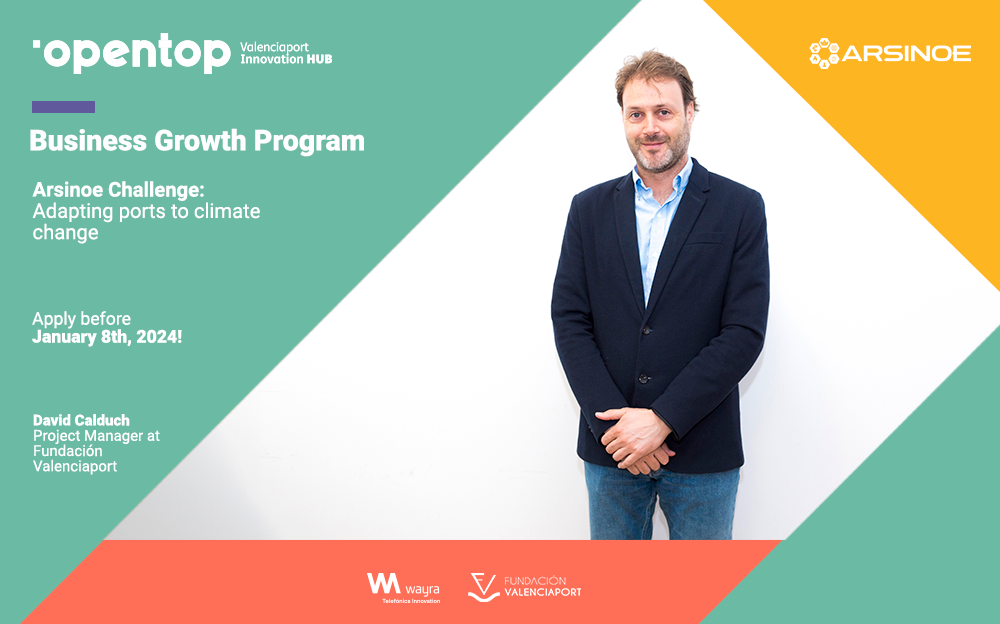LATEST NEWS
«Adapting ports to climate change», Arsinoe’s challenge for Opentop’s Business Growth Program
21/12/2023. Opentop launched yesterday the first of the challenges of its new Business Growth Program, as part of its strategy to continue facing with open innovation challenges of the port logistics sector.
The ARSINOE project is the entity behind this challenge «Adapting ports to climate change», to which startups can apply with their proposals until January 8, 2024.
We talked about this challenge with David Calduch, Project Manager at the Fundación Valenciaport.
How was this need detected? Why is the challenge important for the company?
Port Authorities and their users need to know how climate change will affect their current and future facilities and the operations they carry out in the port. The climate change observatory of the Port of Valencia would be the pioneer in Spain and will allow the design of infrastructures that adapt more efficiently to future climatic and oceanic conditions, in a more sustainable way and with the least possible damage to the operation of the port.
What opportunities can this challenge have in the market?
The implementation of the observatory in the Port of Valencia will serve as a pilot experience, allowing the solution to be extended in the future to the rest of the Spanish Port System by integrating with the SAMOA platform of Puerto del Estado, and even to other Mediterranean ports with the support of OpenTop and the Climate Innovation Window managed by Brigaid Connect as a partner of ARSINOE.
What kind of startups is this challenge looking for?
A startup with knowledge of climate databases and climate projections such as those of Puertos del Estado, AEMET, the Port of Valencia and with whom it is easy to cooperate to develop a customized solution, and attractive solution for the end users, which will be both the concessionary companies as well as the Port Authority.
Have you tried to solve this challenge before? How?
Puertos del Estado has had the idea for some time to implement a Climate Change Observatory throughout the Spanish Port System, but coordinating the more than 40 port authorities is complicated and slow, as each one has its own priorities and pace, so it seems a good solution to start with a pilot test in a port authority such as Valencia where there is already a lot of progress in terms of assessing the effects of climate change.
It could be helpful for startups to register with the Port of Valencia’s SAMOA application to familiarize themselves with its environmental scorecard.
The challenge in detail
Traditionally, port infrastructures have been designed considering past climate events. However, since the climate is changing, these infrastructures must be sized taking into account future climate conditions. Moreover, it is important for port managers to know when they will need to implement adaptation measures for their facilities and operations to address the effects of climate change.
Finding a solution capable of determining which of the downscaling or particularized climate scenarios or as originally called Representative Concentration Pathways of IPCC for the Port of Valencia aligns better with the reality of the port is crucial. This will provide a decision-making tool to establish future climate variables and, in a way, predict which climatic issues will impact port operations. Additionally, the tool should allow correlating oceanoclimatic events with their effects on infrastructures and port operations to assess real impacts. This serves as a foundation for designing adaptation measures.
The goal is to establish a climate change impact monitoring system that integrates past, current and forecasted oceanic and weather variables as currents, wind (speed and direction), water and air temperature, rainfall, etc. This type of data could be gathered from the Port of Valencia meteo stations, SAMOA system or AEMET. Additionally, terminals operating in the port should be equipped with a user-friendly tool, like a mobile app, allowing them to quickly and clearly report any events (shutdowns, damages, delays, etc.) caused by climatic conditions. This way, real-time data on the evolution of variables and their impacts on port infrastructures and operations will be available.
The extended observation of both variables and events should enable predictions based on variable forecasts. It will also allow verifying whether the variable forecasts obtained during the modeling phase align with the actual climate evolution. This verification will help assess whether the real evolution conforms to the likely or unfavorable climate scenario. This, in turn, will assist port authorities in obtaining the most accurate future climate predictions, facilitating proper sizing of new infrastructures and determining when adjustments to current facilities are necessary.
Don’t miss the opportunity and apply to this challenge before January 8th, 2024!




